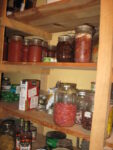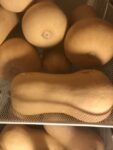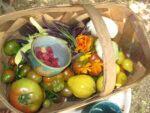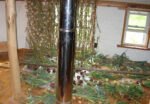A version of this column first ran in the Roane County (WV) Reporter and Times Record as part of a gardening series. Support local journalism! Subscribe to your local newspaper. This is one of a series of blogs for new gardeners. Start reading the whole series here: Part 1.
I garden organically. What does that mean? First of all, let me clarify that the USDA has created a seal which farms can use on their produce if they are certified and inspected, adhering to a long list of practices; this is expensive and time-consuming and many farmers don’t bother with it even if they choose to grow organically.
What I mean is that I don’t use pesticides—except for Bacillus thuringensis and spinosad, both of which are naturally occurring organisms which attack, respectively, the worms that get into brassicas and the beetles that get on potatoes. Both of these and a number of others are allowed by the USDA organic program.
I also don’t use artificial fertilizer. But it is necessary to replenish the organic matter in the soil, since some has been removed with the vegetables and the weeds. So I add manure, compost, or leaf mold—and sometimes small amounts of wood ashes and sand. The sand is added to improve the texture of my clay soil; it has no nutrients. The wood ashes have potash and perhaps other useful minerals but also raise the pH, for which reason I have to be careful not to add too much. I try to add an inch of organic matter to each bed every year. Another way to do this, though, is with cover crops which winter over in the garden, leaving behind their root mass when the tops are removed in spring.
I avoid poisons in general, but I especially dislike the idea of spraying anything toxic on my food. I’ve never forgotten a friend 40 years ago, telling me about watching a cat walking through the fields of peppers and celery on his uncle’s farm in Florida when he was a kid, the day after spraying. And then watching the cat drop dead.
Aside from not wanting to poison my own food, there is the ecological logic of avoiding poison. Commercial crops are heavily sprayed, which can seem a necessity on large farms growing nothing but one variety of one crop, perhaps the same crop as last year. Such a situation is an engraved invitation to whatever pests are interested in that crop. But the poison usually doesn’t kill every last bug (or bacterium or virus or spore). The ones that survive are the ones that produce the next generation—so inevitably, resistance evolves in the pest population, and soon the farmers are spraying more toxic compounds more frequently.
Meanwhile, there is a naturally occurring army of organisms interested in helping farmers deal with pests. Bugs are eaten by larger, predator bugs, and by birds, lizards, snakes, frogs—so all of these are welcome in my garden. But where poisons are sprayed, the toxins often pass through to the predators, and some of them concentrate on the way up the food chain. So now the farmer has killed off his allies against the pests. Additionally, the sprays are often toxic to honeybees and other pollinators, on whom the farmer may depend for pollinating the crop.
There are ecological issues that go beyond the garden or farm. Fertilizers are primarily made from natural gas; producing this is a major environmental harm. Then, when a large amount of fertilizer is applied to the soil for a hungry crop like corn, grown in soil that has been relentlessly plowed and compacted, and the organisms in it killed…much of the fertilizer runs off, into local waterways and eventually rivers and oceans. There it causes algae blooms and dead zones.
Tree fruits are among the more difficult crops to grow organically, while flowers are easy. I think this is because pests like more or less the same things we do—so flowers, being eye candy rather than food, don’t get hit too hard… while a nice crunchy apple or a juicy peach looks good to quite an assortment of bugs, birds, fungi, bacteria, viruses and worst of all, the squirrels. Probably I should say no more about the squirrels, that being a problem I haven’t solved. I may have to take down the picture of a nest of baby squirrels, really very cute, but…I now see them as The Enemy. Part of successfully growing tree fruits successfully is getting over the idea that they all have to look perfect.
Success in gardening organically comes from keeping the soil healthy and alive, not working it too much, and keeping living roots in it all year if possible (by planting perennials, or by using winter cover crops). Mulch in summer helps keep moisture in and temperatures lower. Rotation of crops accomplishes two things. If you grow the same crop two or more years in a row in the same soil, it may have trouble finding its preferred balance of nutrients; a different crop will look for slightly different ratios. And secondly, whatever pests bothered the crop may be lurking in the soil, waiting over winter for next year’s crop. Ideally we disappoint them, putting in a crop from a different family. Many pests are very picky eaters, fortunately. Squash bugs will hit any kind of squash, and in desperation will attack melons and cucumbers, but they just won’t bother corn or tomatoes. Your garden is one restaurant where the manager wants to leave the “customers” hungry.
Read the rest: Part 1. Part 2. Part 3. Part 4. Part 5. Part 6. Part 7. Part 8. Part 9. Part 10. Part 11. Part 12. Part 13. Part 14. Part 15. Part 16. Part 17. Part 18. Part 19. Part 20. Part 21. Part 22. Part 23. Part 24. Part 25. Part 26. Part 27. Part 28. Part 29. Part 30. Part 31. Part 32. Part 33. Part 34. Part 35. Part 36. Part 37. Part 38. Part 39. Part 40. Part 41. Part 42. Part 43.













